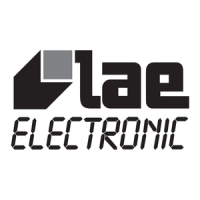on, while cooler and defrost outputs are off. If dty=ELE, during defrost the cooler is switched off and the defrost output on. If dty=GAS, cooler and
defrost outputs are on all through defrost.
6.2 T
ERMINATION
. When defrost is on, it can be terminated on either temperature, when T2 matches the dLi value, or when the maximum time dto
has elapsed.
6.3 D
RIPPING
. After the heating phase, the dripping time drP, by delaying the cooler re-start, allows a homogeneous heat spread all over the
evaporator and the drain of the drops of water.
The defrost LED is lit when the corresponding output is On; it blinks during defrost through "air blowing" and dripping time.
When probe T2 is faulty, any new defrost is inhibited.
7. EVAPORATOR FAN CONTROL
7.1 R
UN WITH
T
HERMOSTAT
. During temperature control, the fans can work in three different ways. If Fct=-01, the fans work continuously. If Fct=00,
the fans are stopped simultaneously with the cooler. If Fct is set between 1 and 10 minutes, after the cooler has stopped, the fans continue to run
for the programmed amount of minutes. In both latter two cases, the fans are switched on simultaneously with the cooler.
7.2 R
UN DURING AND AFTER
D
EFROST
. During and immediately after defrost, the fans are controlled by parameters Fid and FrS. If Fid=00, at the
start and all through defrost the fans are off; they are switched on again, after compressor re-start, when the evaporator probe T2 matches the FrS
temperature. If Fid=01; in this case the fans are active as long as the evaporator has a temperature lower than FrS. If Fid=02; all through defrost
the fans are on (even with dty=ELE or GAS).
8. ALARM FUNCTION AND PROBE FAILURE
A check on the correct refrigeration plant function is performed by monitoring temperature T1, T2 or T3, selectable via Ain parameter. ALo and Ahi
determine, respectively, the lower and higher temperature alarm threshold.
AdL allows the control of the alarm function: with -01 the temperature alarm is excluded, while, if this parameter is 00, the alarm output is on
immediately when the condition is detected. If AdL is programmed between 01 and 120 minutes, the temperature must constantly remain over the
alarm threshold for the chosen time before the signallings take place.
When the alarm starts, “ALM” blinks on the display, alarm relay and buzzer are switched on. The signallings remain, even when the alarm
condition is over, until the alarm is "acknowledged" by pressing any key. Now, if the temperature is within the alarm limits, any alarm indication
disappears. Otherwise the current temperature is displayed alternating with “ALM”, the relay is always on and, for 1 min. every 30, the buzzer beeps;
all this happens as long as the alarm condition persists.
As a result of failure or overrange of one of the probes, the display shows either “PF1”, “PF2” or “PF3”, the alarm output is switched on immediately.
Also in this case the condition must be acknowledged by pressing any key.
The alarm output contact is also closed when the instrument is powerless.
During defrost and dripping, the high alarm monitoring is inhibited.
9. PROBE RE-CALIBRATION
Should it be necessary to recalibrate the unit, for instance in consequence of probe replacement, then act in the following way: get an accurate
reference thermometer or calibrator; make sure that the offset oSx of the probe to be re-calibrated is 00; switch off then on the unit. During
the self check (5 seconds from power-up), press + + . When the re-calibration function is active choose the desired section by means of or
: 0A1, 0A2 and oS3 allow 0°C calibration of the respective probe. SA1, SA2 and SA3 allow high temperature calibration to rectify a gain
error. After selecting the desired parameter, press + or to match the read-out value with the one of the reference instrument (make sure the
temperature is stable).
Exit from the recalibration occurs after 10 seconds of no key activation. Therefore, to avoid exit, keep pressed for as long as you need.
10. SERIAL COMMUNICATION
If fitted, the RS485 serial port allows the RDC12 to take part as a peripheral in a data communication network managed by a master PC supervisor.
The data base puts all measurement and control data on line as well as the output status. Adr is the unit identification number within the network.
Through the serial communication it’s possible to change all control parameters (setpoint and SETUP), start defrost cycles, put the controller on a
standby or inhibit the controller keypad in order to avoid unauthorised access to programming function.
WARRANTY
LAE electronic Srl warrant that their products are free of any defects in workmanship and materials for a period of 1 (one) year from date of production
shown on the enclosure. LAE electronic Srl shall only repair or replace those products of which defects are due to LAE electronic Srl and recognised by their
technicians. LAE electronic Srl are not liable for damages resulting from malfunctions of the products.
Defects due to exceptional operating conditions, misapplication and/or tampering will void the warranty.
All transport charges for returning the product to the manufacturer, after prior authorisation by LAE electronic Srl, and for the return to the purchaser are
always for the account of the purchaser.

